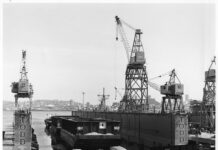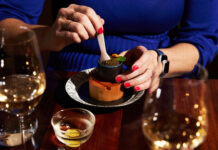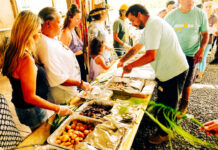The Great Seattle Cookie Bake-Off
Frozen cookie dough offers a shortcut to the house-filling smells of melting chocolate and sizzling butter. But the world has moved far beyond the classic plastic tubes and bland flavors of slice-and-bake doughs. Some of Seattle’s most famous cookies now come as premade dough shoppers can grab at the grocery store and bring home to cook at their leisure.
I baked and tasted my way through a dozen types of cookies—with help from my 7- and 9-year-old self-appointed official tasting assistants—to determine which ones lived up to the in-store versions.
Hello Robin, Birthday Cake Cookie Dough
Winner
Pastel sprinkles and a rich vanilla dough conceal the molten white chocolate center of these fun, colorful cookies. Like all the Hello Robin cookies, it comes as a frozen 12-pack of preportioned balls that bake up beautifully in exactly the prescribed time.
$18–21 for a bag of 12 dough balls
Runner-Up
Chewy and electric purple, with the sweet complexity of its star ingredient, this scoop-it-yourself cookie dough has some advantages. The instructions suggest a tablespoon-size portion, which, even generously scooped, would make 16 servings—of rather small cookies. But it was nice to be able to tailor the cookie size to our mood—little ones for a snack, larger ones at dessert. The downside is that this one lives in the fridge, making it more perishable than the frozen contenders.
$15 for a pint of dough (makes 12–16 cookies)
Best Gluten-free and/or Vegan
As with their more famous ice cream, Frankie & Jo’s manages to make vegan, gluten-free cookies that absolutely stand up to—and often best—any traditional version. The flavors are creative, and while I enjoyed the miso oat variety, the lacy caramelization of the chocolate chip was the crowd-pleaser, despite the 18-minute bake time. Thankfully, these have the bonus of being totally safe to eat raw or cooked.
$16 for a bag of eight dough balls
Honorable Mention
If it were not for how good the in-store version of “The Cookie” is, this dough might have done better. (Full disclosure: I was the marketing manager for Metropolitan Market when the Cookie launched more than a decade ago.) The bake-at-home balls are a fraction of the size, which makes the chunkiness that’s great in the larger version slightly overwhelm the dough. Completely divorced from the in-store version, it’s a good cookie and a great value compared to other premium bake-at-home options.
$6 for a box of six dough balls
Seattle’s Thai Cuisine Is on Fire at Larb, Roy, and Gao Lhao
Gao Lhao brings the excitement—and food—of Bangkok's Chinatown to Green Lake.
Younger siblings are boisterous, gregarious, rebellious. They get loud and question authority while their older siblings stick to rules and color within the lines. When our server at Larb left a small burner, already lit, uncovered on our table while they returned to the kitchen for our hot pot, one of my daughters poked the blue flame with a spoon. Her big sister quickly chastised her. Larb is itself a little sibling—from the same folks as the U District’s Thaprachan—and suitably charismatic from an early age, ready to prod everyone around it into rethinking the tacit rules of local Thai restaurants.
Since Larb opened in July, two more younger sibling Thai restaurants have opened in Seattle: Gao Lhao from the folks behind Kin Len Thai Night Bites and Isarn Thai Soul Kitchen, and Roy Southern Thai Cuisine from the Pestle Rock and Sen Noodle Bar team. Each brings to life a specific regional Thai cuisine with niche dishes not seen on the menus at the city's myriad Thai restaurants, and does so in true younger sibling fashion: norm-busting, vivacious, and utterly charming.
Shoreline's Larb prioritizes making Thai food to appeal to Thai customers.
Larb Thai Street Food
Larb focuses on Isaan cuisine, as many restaurants claim to, but here, it tastes like the Northern Thai and Lao dishes served at rickety tables in Chiang Mai and in bubbling pots set out along the Mekong in Luang Prabang. In a world of sweet chili sauces boring enough to put a Muay Thai fight crowd to sleep, the one Larb serves alongside fried fish cakes lands a knockout punch, building heat with a slow burn, popping with peanuts and cucumber crunch.
“We think about Thai people, number one,” says Panarat Imig, who goes by Ying. The manager and one of the three partners behind Larb, Ying has worked in Thai restaurants in Seattle for nearly a decade. When she and Salisa Chaowanawathi (her partner in Thaprachan) teamed up with a third former coworker, Irada Phuetphakwan, they set out to do things differently at the restaurant just across the city border in Shoreline.
The wood paneled interior of Larb imitates that of traditional Thai houses.
The group chose Isaan cuisine in part because of Phuetphakwan’s cooking it, in part because of its popularity in the Thai community, and in part because of the vibe they knew it would create. The salad, for example, is spicy, Ying explains, so you have to have lots of accompaniments—dried meat, sausage, pork rinds—and that brings something else. “The laughter, the sound that it makes, that makes it more fun for us, like more alive.”
The liveliness is palpable at Larb, something Ying aimed for when they centered the menu on yak jim joom, the hot pot that arrived to cover the open flame on my table. Her idea was that the active participation of dipping and dunking would force people to put their phones down and spark more conversation. It worked, even if our conversation was mostly wondering if there was a proper order to dipping the platter of raw meat and egg and selection of vegetables into the broth and pair of sauces. Other dishes, like the mushroom larb—a culantro-scented vegetarian take on the ground meat salad—needed no such help.
Larb has hot pot on the menu in part because the interactive nature encourages people to put their phones down.
“We’re trying to be in Thailand,” Ying says, pointing to the metal cups that keep the water cool and the walls of patterned dark wood paneling as if in a traditional Thai house. Details like the ceramic jar on the wall, traditionally used for fish fermentation—but for many families, where the money was kept—offer a subtle wink at the restaurant’s primary audience.
Jennifer and Saravut Nawasangarun use what they learned from their previous restaurants to push Seattleites out of their comfort zones and into Bangkok's Chinatown.
Gao Lhao Bangkok Noodle Shop
The decor speaks louder at Green Lake’s Gao Lhao, where neon lights and murals of street vendors telegraph the specific excitement of Bangkok’s Chinatown. Happy hour kicks off with boozy chrysanthemum or Thai tea slushies and hot plates sizzle to the table with steak and garlic butter rice. “Everything is a lot of art,” says cofounder Jennifer Nawasangarun. “The experience that you actually come into, the feelings that you feel, the music that you hear, the food that's created.”
Jennifer and her husband, Saravut, opened their first restaurant, Isarn Thai Soul Kitchen, in Kirkland in 2014. “It was a struggle for me,” she says. “There were dishes that we wanted to introduce that the community didn’t fully understand.” While they pulled some regional dishes from Isaan cuisine, they felt forced to supplement with other dishes more familiar to customers.
Neon lights and murals bring Yaowarat Road to life inside Gao Lhao.
They opened without pad Thai on the menu, but eventually acquiesced to customer demand, theorizing that maybe from there, people would branch out. In 2020, they used what they learned to open Kin Len Thai Night Bites in Fremont, educating customers on what makes dishes special and where the flavors come from. “It was a level up for us, to be able to connect with the customer a bit more, and they were more open.” At Gao Lhao, they turn that up another notch. “Having the server actually being able to relate the dish and explain to a customer about where this is coming from and getting to know a little history of it.”
That history, specifically, comes from Saravut’s experience growing up Thai Chinese and going with his parents to Yaowarat Road, the bustling boulevard at the heart of Bangkok’s Chinatown, to shop for Chinese herbs and maybe stop for lunch at roadside stands. A painting of an elderly man smiling as he stirs a pot dominates the back wall, a lit sign above advertises the soup; tiffins, teapots, and glass jars of dried ingredients decorate the bar.
The colors and textures, the khaki vests the servers wear emblazoned with the restaurant’s name, the music; it all feels exciting, as if I’m joining a stroll down the busy street. But it’s the food that cements it. Like Larb, the food sidesteps the familiar classics of Seattle Thai food. It’s more along the lines of what Saruvat might have eaten at one of those roadside stands back in Bangkok. My best advice: Order like a drunk person wandering the street late at night, following your nose and the green neon lights. The biggest hits come from venturing out of the familiar and choosing the smoky pandan leaf-wrapped chicken, dipped in sweet soy sauce instead of the more typical fish sauce wings to start. The almond yuzu salad seemed as if ambrosia salad spent a month backpacking through Southeast Asia. The crisp garlicky wild cod looked like adult fishy nuggets but tasted like fine dining. The Chinese black olive green beans were the most surprising hit from my meals there; the less I could imagine what the dish might taste like, the better it turned out.
“In Thailand, there’s so much culture, it’s not just the Thai culture itself,” Jennifer explains. Northern, Southern, Chinese, and all kinds of combinations. “It’s growing, and it’s changing and shifting… It gets more interesting.” The same can be said of Seattle’s expanding, exciting Thai food scene.
Roy Southern Thai Cuisine
When the Jawpliphon siblings’ Pestle Rock opened in 2012, it was among the early restaurants pushing Seattle out of the pad Thai cave, using big bowls of khao soi noodles in creamy coconut broth and the crunchy rice of yum khao tod. Now, at Phinney Ridge’s Roy, they explore in the opposite direction from their hometown of Bangkok, sliding down the country’s south as it extends along the Malay peninsula, drawing influence from Malaysia, Singapore, and even the subcontinent across the water.
The bar at the center of the room still reflects the space’s long run as a neighborhood pub, but now it’s tiled in turquoise, and backlit, though the many televisions behind it remain tuned to sports. A flag of Thailand is joined by a rainbow pride flag, and fresh greenery hangs in pots from the ceiling. The sunny feel of the citrus-bright walls matches the color of turmeric-flecked wild rockfish curry into which my impulsive youngest discovered the delights of dipping layered roti. The same dish introduces me to the green leaf called chaplu.
Seattle still lacks a Bangladeshi restaurant, but Roy serves its own version of beef bhuna, the country’s thick, rich curry. The herbal broth on the bak kut teh, a pork bone soup, has Hokkien roots. The stuffed mataba flatbread is a traditional Thai Muslim street dish. With each item, the restaurant extends Seattle’s notions of Thai food and introduces another facet of the country’s cuisine.
“A lot of Thai restaurants have been afraid to come out of that safe zone,” Jennifer says, making them hesitant to put new dishes on the menu. “But once they see that one person does it and it works, then they start doing it.” The winners, when they do, are Seattle diners.
My Life in the Shipyards
It was well after midnight in the Central District, and the businesses along 23rd and East Madison were closed, except for the Honeysuckle Tavern: It was still going strong, even at this hour. I tried to make myself comfortable leaning against the door of the Ship Scalers Union Hall, my way of assuring I’d be the first person in line for the early-morning job call.
A little after 2, tavern barflies emptied into the street, trying to find their cars, and by 2:30, East Madison was completely deserted, dark and silent. I sat with my back against the union hall door, a blanket over my shoulders, my eyelids growing heavy. That’s the last thing I remember before the stillness was shattered with “You can’t sleep here! You can’t sleep on the sidewalk!”
I jumped, startled by the booming voice, eyes now wide open. The problem was, I couldn’t see anything because of the oversized flashlight directly in front of my face.
Ship scalers usually worked at the Todd (pictured) or Lockheed Shipyard on Harbor Island.
In my own naive way, I’d assumed that if I went to college, worked hard, and earned a degree, a well-paying job would automatically fall into my lap.
“Let’s go,” the voice commanded, as the flashlight waved. I blinked a couple times and recognized the metallic glint on some sort of suit on the other side of the light. “I said let’s go,” the voice repeated, and I recognized the uniform of a Seattle Police officer.
I disentangled myself from the blanket and cleared my throat. “I’m trying to get a job,” I managed to get out, half sitting up. “What I mean is”—I cleared my throat again—“I’m trying to get in line for a job call.”
Mike Nolan arrived in Seattle thinking he’d walk into a “good” job. Then reality set in.
A month earlier, I had relocated to Seattle with my bachelor’s degree in hand, landing at my older sister’s house. Nancy lived with her husband, Dave, in an aging bungalow in Beacon Hill. With two small kids, their tiny house was already crowded, so I slept on the worn green couch in their living room.
That first afternoon I sat, coffee cup in hand, poring over the newspaper in Nancy’s kitchen. It was the late ’70s, disco music was sweeping the country, and finding a job began with scouring the Help Wanted section of The Seattle Times. The page was large, and the newsprint was small, so by my rose-colored calculation there were hundreds of job openings waiting to be filled.
Reality hit hard the following morning when I tried to track down addresses in the city and follow up on applications. I wasn’t familiar with Seattle, didn’t know the layout of the downtown streets, couldn’t even find parking. When I finally made a connection, I would fill out paperwork and receive a polite “Thanks, we’ll let you know.” By the end of the first day, I’d turned in a total of four applications.
Days wore on and I continued filling out applications, but I didn’t have any follow-up meetings or interviews. I heard the same “Thanks, we’ll be in touch if we need you,” but no one got in touch.
In my own naive way, I’d assumed that if I went to college, worked hard, and earned a degree, a well-paying job would automatically fall into my lap. As a white, entitled college-educated male, this was a foregone conclusion. In retrospect, that was so presumptuous. I didn’t consider the things that needed to happen between earning my degree and being offered a job.
I spent four weeks getting nowhere, and tried to keep up a brave face as misery built up inside me. My efforts in college had been rewarded with recognition, good grades, and a diploma. Now I put the same level of dedication into job hunting and struck out. I tried to remain hopeful when I pulled up to Todd Shipyard in West Seattle. As I ambled to the main gate, a uniformed security guard directed me to an aging wooden building. I found the personnel office on the ground floor, walked in, and asked if they were hiring. The man behind the desk stopped what he was doing, leaned back in his creaking metal chair, and set his glasses on the desk. “Yes,” he said slowly, “we have openings. What craft are you?”
The Todd Shipyard on Harbor Island opened in 1918, and eventually built hundreds of ships during World War II.
What craft am I? My blank look was enough to tell him I needed information.
“Craft is another word for trade,” he explained. “A trade is like welder or pipe fitter, or shipwright or rigger. Those are all shipbuilding trades.”
“Oh…ah…I’m not any of those.”
“Well then, if you don’t have a specific craft, you’ll want to hire on as a laborer.”
Laborer? My thoughts stuttered. I’m going to hire on as a laborer? I was a biology major. I graduated with honors. But I was also broke.
Staring at me, he patiently asked, “So do you want to hire on as a laborer?”
“Sure,” I said, nodding. “Do you have an application I can fill out?”
“No, it doesn’t work that way. All of our tradespeople come to us through union halls. If you don’t have a specific craft, you’ll want to join the laborers union.” He handed me a card. “Go sign up with these guys. They’ll get you started.”
The card read “Ship Scalers, Dry Dock, and Boat Yard Workers Union” along with a street address in the Central District. My eyes lit up as a genuine smile of relief relaxed my face. I felt lighter. I might have even heard music playing. “Thanks,” I said.
It only took me four weeks, but I finally had a solid lead on a job.
The next day I stood at the corner of 23rd and East Madison. The Central District enjoyed a rich cultural and musical heritage, counting itself home to Quincy Jones and Jimi Hendrix. A teenage Ray Charles launched his career here. In the late ’70s, the neighborhood was about 70 percent Black and had been the epicenter of the civil rights movement for the people of Seattle.
This was a fitting location for the Ship Scalers Union Hall, because its membership was heavily African American. It hadn’t always been so. The union started out in the Belltown area, originally composed of European shipyard workers. Prior to the Second World War, shipyard unions actively discriminated against Black people, barring them from membership or, in some cases, segregating minority workers into “auxiliary locals.” As Black soldiers were integrated into the US Army, a door eventually creaked open for Black workers in the shipyards. It wasn’t much of an opening. The craft unions, representing skilled workers, continued to discriminate by and large, but the Ship Scalers Union—the laborers union—opened membership to minority workers. Ship scaling was the least desirable work in the shipyard: dirty and dangerous, not to mention the lowest paid. But this was the only door open to African Americans, so they became the majority in the Ship Scalers Union, eventually making up about 90 percent of its membership in the years after the war. The Ship Scalers went on to become a progressive voice in Seattle for social change, integration issues, and civil rights.
The Ship Scalers Union was a progressive voice in Seattle dating back to the 1940s.
Standing in front of the union hall that morning, knowing none of this, I studied the peeling paint. With “Ship Scalers Union Local 541” posted over the door, the building’s run-down appearance belied its venerable history of activism and fighting for social justice. Walking inside, I felt out of place. Against one wall was a row of rickety wooden chairs and four Black men talking. They all wore faded gray coveralls and scuffed black work boots. The men looked up for a second, said nothing to me, then went back to talking among themselves.
All of a sudden, I sensed how white I was. Is this how it feels? I wondered. I’d gone to a high school with no Black students, and only known two or three Black students at college. Was this the sort of feeling they experienced each day on campus? Was this what they felt, magnified on a much greater scale, every time they walked into a classroom full of white people?
I walked across the room to an office behind what looked like a plexiglass bank teller’s window. A thin, ancient Black man leaned back in an old swivel chair. Approaching the window, I bent forward and said, “I’d like to join the Ship Scalers Union.”
The man didn’t look up. He didn’t even move. Instead, he took a long breath, then exhaled “8am call” in a voice charred by cigarettes.
I ducked down a little, bringing my face closer to the semicircular opening. “That’s when I can sign up?”
He still didn’t look up, but the lines in his face deepened as he repeated, “8am call,” then swiveled in his chair, turning away from me.
Do I wait here? Do I say something?
I stood there, head down, feeling the men from across the room’s eyes on my back, and realized nothing else was going to happen. I put my hands in my pockets and quietly left, driving back to my sister’s place. Stopping along the way at the giant Sears store on Third Avenue South, I bought coveralls and black, midcalf-high, steel-toed work boots.
Friday morning at a quarter to eight I walked down the sidewalk, counting eight or nine people—mostly men and all older than me—lined up by the door. Wearing my brand-new coveralls, I was met with eyes neither welcoming nor disapproving. I was the only white guy.
Alone at the end of the line, I kept checking my watch: 10 till 8…5 till 8…then, right on the money, the door to the union hall swung open. The line quietly filed in as people queued up in front of the plexiglass teller’s window, and a deep, now-familiar gravelly voice barked out, “Call for four at Lockheed, ship repair, days.” One at a time, the first four people bent down to the window and gave their names. The thin man wrote down each one, and after the four left, the rest of the line queued up expectantly.
Prior to the Second World War, shipyard unions actively discriminated against Black people, barring them from membership or, in some cases, segregating minority workers into “auxiliary locals.”
“Call for two at Todd, ship repair, swing.” The next two people gave their names, and then the man in the office placed a semicircular piece of plexiglass, cut to fit, into the window, sealing it up. He turned around with the list of names, sat down at his desk, and picked up the phone.
Was that it?
“Show’s over,” the person in front of me said as people turned to leave. I hesitated for a second, looked around, then followed everyone out. The show was over. Obviously, I had to be there earlier for the Monday-morning call.
Monday I pulled up in front of the union hall a little after seven, this time counting five people in line. OK…makes me number six. Standing in line, I made some small talk with two guys in front of me, learning that (a) the man behind the plexiglass was J. J. Johnson, president of the Ship Scalers Union; (b) most people were sent to either Todd Shipyard or Lockheed Shipyard; (c) calls were for day shift, swing shift, or graveyard; and (d) people were sent to either “ship repair” or “new construction.”
I absorbed the information, although I didn’t fully appreciate all the implications yet. Precisely at eight o’clock the union hall door opened, and we filed in. By now there were 10 or 12 people in line and I smiled, feeling confident being number six. From behind the window J. J.’s voice rang out, “Call for three at Lockheed, ship repair, swing.” After the first three people in line gave their names and left, the plexiglass insert went back into the window. J. J. sat down to phone in the names. End of story.
This is getting frustrating…tomorrow morning I’m going to be first in line.
I had the rest of the day to kill and no job openings to pursue. Tomorrow morning I’m going to be first in line. I didn’t feel like spending the night at Nancy’s, so after changing, I left my sister a note, then drove around the city. Ending up in Chinatown, I bought a bowl of noodles at a little restaurant. I ate slowly, drank a lot of tea, and wasted enough time to arrive at the union hall around midnight. That’s when I had my encounter with the Seattle Police officer, who was the last person I saw until about 6, when two guys walked by, one white and one Black, both a little younger than me.
“You waitin’ for the 8am call?” they asked. I nodded. “Mind if we join you?”
Their names were Willy and Derek, buddies who graduated from Garfield High School that spring. They heard ship scaling was a good-paying gig and were impressed when I told them I’d arrived at midnight to be the first person in line.
Time passed quickly as we fell into conversation, and by eight o’clock there were six people in line behind us. The door swung open right on time, and I marched into the union hall with a self-satisfied grin. First in line!
Just like that, I had a job. I possessed identity. I was Mike Nolan Ship Scaler, and I couldn’t wait to tell somebody—my folks back home, my sister Nancy—anybody.
The union president, J. J., looked up from his chair and barked, “No calls today!”
We stood there, momentarily frozen, as J. J.’s words bounced off us. Christ! What’s it gonna take? I rolled my eyes and turned away. So much for being first in line.
Looking at Willy and Derek, I cleared my throat and swallowed my frustration. “Guess that means I’ll see you guys tomorrow morning.”
“Yeah, early in the morning,” Willy shot back, a little bleary-eyed.
I arrived at midnight, and my new friends showed up a little after 1am. This time, hanging out in front of the union hall was fun: With Willy and Derek, it was like a junior high sleepover. I had a blanket, Willy brought two sleeping bags, and Derek showed up with a bag of Doritos and a box of Twinkies, which we devoured. We talked the whole evening.
By eight o’clock a dozen people were in line, and bang on the dot, the union hall door swung open. Once again, I led the procession to the teller’s window. This time, J. J. said the magic words. “Call for two at Lockheed, ship repair, days.”
Finally! Being first in line, I couldn’t wait to give my name, but I wavered. I knew Willy and Derek hoped to be called out together, and this was a call for two. I backed away…after all, they had brought the food last night. “You guys go ahead of me. It’s a call for two.” Willy and Derek went around me and gave their names while I prayed that J. J. would keep talking.
My anxiety was short-lived. “Call for four, Todd, ship repair, swing.”
This time it was my name J. J. was writing down. “So I just show up at Todd Shipyard?” I asked.
“Right,” J. J. replied. “I’ll phone your name over there, so be at the yard by four o’clock today. They’ll be expecting you.”
“OK.” I nodded. “Thanks.” I shook hands with Willy and Derek, wishing them luck, then bolted from the hall. Just like that, I had a job. I possessed identity. I was Mike Nolan Ship Scaler, and I couldn’t wait to tell somebody—my folks back home, my sister Nancy—anybody. I had no idea what a ship scaler did, but that didn’t matter. At four o’clock I’d find out.
That afternoon I pulled up to a crowded Todd Shipyard parking lot. When I told the security guard at the main gate I was sent from the union hall, he pointed to a rack of hard hats. “Put one of those on.” Then he handed me a blank punch card. “Here, print your name at the top—and print it so they can read it, or you won’t get paid.” He pointed to a small clock mounted on a post at the end of a huge metal rack full of time cards. “Punch it there.” I stuck one end of my time card into a slot beneath the clock and—stamp!—the time appeared on my card. “Now take it over there.” He pointed in the direction of the company offices.
At Todd, Mike Nolan learned the difference between a ship and a boat. And also the best way to utilize the f-word.
By now the other three scalers from the union hall had shown up. While the guard got them going, I walked to the administration building. The man sitting in the personnel office was the same person who had directed me to the Ship Scalers Union. “OK…you four will be working on the Thomaston. She’s tied up to the pier across from the shipways. This is Henderson.” He gestured to another man who had silently walked into the office behind us. He was a short, solid, powerfully built Black man with a thick mustache, and I could tell from his demeanor that he was not a new recruit. “Henderson is your leadman. He’ll show you what to do.”
Henderson wore dirty blue coveralls. A laminated Todd Shipyard badge showing a headshot and barcode was clipped to his breast pocket. His hard hat had a large capital L on the front, and his commanding presence exuded unspoken confidence; in other words, he was everything I was not.
“Why don’t you gimme your time cards,” Henderson said in a low monotone. Collecting the cards, he slowly read each name, then tucked the stack into his shirt pocket. “OK…follow me.”
It was loud and hurried and seemed erratic, but at the same time the movement possessed an energetic rhythm and geometry: perfectly organized chaos. I loved being in the center of it all.
The four of us shuffled out behind Henderson and followed him to the tool room. “Canvas work gloves,” Henderson said to one of the men behind the counter. Someone took Henderson’s badge and scanned the barcode. We were issued safety glasses, and Henderson pointed to a box of earplug packets on the counter. “Grab y’all some of those.”
After that, he looked at us with absolutely no expression and said, “OK,” which I guess was his way of saying, “Follow me, guys, and I’ll take you to the worksite.”
We walked past a massive navy vessel on the shipway, a “fast frigate.” Two towering cranes wheeled up and down the pier alongside it, loading pallet boards onto the vessel’s main deck. Scaffolding had been erected all along the hull, with three or four guys perched in various places, welding. Golden sparks flowed down the sleek gray hull in narrow, shimmering waterfalls.
Throughout the yard, workers moved in every direction, carrying tools, dragging hoses, lugging equipment…with forklifts driving in between them all. I paused for a second and looked around, pressed in by the noise and frenzied activity all around me. Everything was in motion. It was loud and hurried and seemed erratic, but at the same time the movement possessed an energetic rhythm and geometry: perfectly organized chaos. I loved being in the center of it all.
Past the shipways, Henderson led us down a long wooden pier where the Thomaston, a haze-gray navy vessel with an oversized 28 painted on her bow, was moored.
“Is this the boat we’re working on?” I asked Henderson, walking down the pier.
“Ship,” he said without breaking stride.
The four of us followed Henderson up a lengthy aluminum gangway, climbing from the pier to the main deck of the Thomaston. One of the scalers behind me, who obviously had more experience, leaned forward. “You can put a boat on a ship, but you can’t put a ship on a boat.”
I turned around. “OK…I get it. It has to do with size.”
“Uh-huh.”
“One’s a lot bigger than the other. Like ‘life boat’ versus ‘battle ship.’”
“You’re learnin’” was the laconic reply.
Henderson led us below decks and through what seemed like a maze, until we came to a compartment—not a room. “This is where day shift left off.”
The compartment was empty except for four aluminum ladders and a big bale of rags. Heavy brown paper covered the floor—the deck—and the light fixtures were wrapped in clear plastic sheeting and masking tape.
In my head, I was asking myself how I could be so smart—I graduated cum laude—and at the same time so ignorant.
“Y’all get ya a ladder.” Henderson bent down with a pair of pliers and clipped the baling wire on the bundle of rags. “We’re gonna get this space ready to paint.”
“We’re going to paint it?” I asked.
“Fuck no. We’re gonna get this fucker ready to be painted,” he said matter-of-factly. “The fucking painters gonna fucking paint it.”
The look on my face was probably something like there’s a lot they don’t teach you in college, but I smiled realizing I’d finally heard Henderson utter more than three words in a row. I was catching on to something else about shipyard terminology, something that would become abundantly clear in the next few days: Everyone used the word fuck, or some permutation of it, continually. With a little bit of imagination, people used the word as a verb, a noun, an adjective, and an adverb. And it went on like that, all the fucking time.
“Get y’all some rags too,” Henderson said, “and wipe down the fucking overhead.”
“Right.” The other guys grabbed handfuls of rags and started up the ladders. The overhead—the ceiling in the compartment—was exposed steel I-beams. They were dusty, and I found stubby, burned ends of spent welding rods. My first eight hours as a ship scaler consisted of wiping down I-beams.
Mike Nolan's first few shifts at the Todd Shipyard were spent wiping down steel beams.
My second and third nights at Todd were just like the first; Henderson would take us to a compartment, “a fucking compartment,” a little farther down the passageway from the night before. I wiped I-beams every night for eight hours; my job lasted three days, and at the end of my third shift, Henderson caught up with me.
“Here.” He handed me a slip of pink paper.
“What’s this?”
“It’s what it fucking says it is.” He pointed to the bold lettering at the top of the pink carbon copy: Reduction in Force.
In my head, I was asking myself how I could be so smart—I graduated cum laude—and at the same time so ignorant. My eyebrows went up as I stammered, “So this is…?”
“You got an R-I-F, man—you know—you got ‘riffed.’” Henderson shrugged. “This here’s your fucking pink slip. You been laid off.”
The next morning I was back in line at the union hall. I knew the first few people would show up between 6 and 7, so that’s when I got there. As it turned out, I was third in line, which was perfect. J. J.’s first call was “Four at Lockheed, ship repair, days.”
That cycle—being sent out from the union hall and getting laid off a couple days later—continued for weeks, until one day a leadman asked me if I was a sandblaster. Knowing sandblasters didn’t get laid off, I lied through my teeth.
“Yeah. I can blast.”
That eventually led me to full-time work and seniority. For four years I had been the quintessential rule follower in college. Compliance—and honesty—were considered virtues. But I didn’t get ahead in the real world until I lied about myself. Life wasn’t turning out the way I expected, but my second education had begun.
This story was adapted from Mike Nolan’s new book, Hardhat Days: My Re-Education in Seattle’s Shipyards, from WSU Press. Some names have been changed.
Eat This: Gas Station Goat Curry
Fill your tank with something premium: butter chicken, goat curry, malia kofta, and daal tadka from Twin Peaks Food and Gas.
When my husband first texted me on the way home from mountain biking that he’d bought lamb and goat curry from a gas station, I worried this would be like the time he bought steaks from a rando in a dive bar. Pro tip: Don’t buy steaks from a rando in a dive bar. (Tamales, yes; steaks, no.)
Thankfully, this was a totally different animal (pun intended). A few nights later, we defrosted the pint containers and heated up the homemade-looking lamb saag and goat curry. Then we sat down to a meal better than most Indian takeout in the city, with tender meats afloat in rich, spicy stews.
Prepacked Indian dishes will make you rethink the concept of gas station food.
Since that first dubious text, we’ve made the Twin Peaks Food and Gas in North Bend a regular stop when heading home from outdoor activities. The gas station itself is about as typical as they come, just off exit 34 on I-90, serving various American-style fried delicacies, a broad selection of chips, candy, and sodas. Only there are a few extra freezers, tucked away in the corner at the end of the counter next to the Bitcoin ATM. Two are stocked with more than a dozen homestyle Indian dishes, $15–20 a pint, including shahi paneer, malai kofta, bhindi masala, butter chicken, and my personal favorite, the goat curry. The other two contain commercially made frozen Indian food—various naans, parathas, samosas, and pakora. We’ve had less good luck with these, though they do in a pinch to round out a meal.
The pit-stop trifecta: mini chapel, beer cave, scrumptious Indian food.
After a long day of skiing at Snoqualmie, few things sound more pleasant than stopping in to grab something that will become a hot, spicy meal for a family of four in less time to heat up than it takes that same family to unpack the car.
How to Rent an Apartment in Seattle
If renting in Seattle were a game, it would require skill, luck, and damn good credit. Tenants vie for a good apartment while navigating complex ordinances, new bills, and perpetually rising costs. Go ahead, roll the dice. But before you do, make sure you know all the rules.
Your security deposit got docked
Landlords can’t keep your deposit for normal wear like scuffed wood floors or a wobbly toilet. The digital library at Northwest Justice Project’s Washington LawHelp.org holds lawyer-drafted letter templates for resolving security deposit disputes and legalese-free explanations of tenants’ rights.
Neighborhood shopping
Denny Triangle, Belltown, Pike Place Market, and South Lake Union have some of the city’s highest rents, while pockets of Bitter Lake, Beacon Hill, Rainier Valley, and Mount Baker boast the most affordable.
Broken sink
The clock is ticking. Landlords must begin to fix some problems within 24 hours: those that leave tenants with a safety issue or without water, electricity, or (in winter) heat. They have 72 hours to get going on repairs to major appliances and critical plumbing issues, and 10 days for anything else.
Application fee
Nonrefundable application fees can only amount to the actual cost of any screenings; in Seattle, anything above $45 per adult is a potential red flag.
Rent hike
Washington’s HB 1217, the 2025 rent stabilization bill sponsored by West Seattle’s state senator, Emily Alvarado, caps rent increases at 7 percent plus inflation, with a hard stop at 10 percent. In the law’s first quarter, just eight landlords across the state were caught breaking it. They were fined $2,000 each. 2026 rent hikes will be capped at 9.683 percent.
Navigate the First-in-Time Ordinance
If you’re not first, you’re last. The First-in-Time Ordinance requires landlords to offer a rental agreement to the first qualified applicant who submits a complete application. The law, unique to Seattle when first passed in 2016 to avoid housing discrimination (Portland has one now, too), faced several legal challenges before the US Supreme Court declined to hear its case in 2020, deferring to the Washington Supreme Court, which had unanimously ruled the edict legal.
How to win housing in a first come, first served world
Quit your job. Welcome to your new position: house hunter. OK, not really, but getting in first requires loads of free time to quickly act on new listings. Clear your schedule.
Have all the common documents and information ready to speed-type into an application: income verification, references from previous landlords, birth dates of all occupants, the works.
When in doubt, tour. Many landlords don’t consider an application complete until the prospective tenant tours the property, whether in person or via a live video call.
Contact property managers directly. It’s not uncommon for hundreds of applicants to submit prefilled Zillow apps within hours of a new listing going live, but don’t get discouraged. Talk with a human, set up a tour, and be ready to sign if you like what you see.
Rental Gymnastics
About 50 percent of renting households in Washington are rent-burdened. That means they pay more than 30 percent of their incomes on rent plus utilities.
King County by the Numbers
$2,146 Average rent
$2.78 Average rent per square foot
771 Average square footage
263,503 Total number of units
To spend 30 percent or less of your yearly income on rent for an average apartment in King County, you need to make at least $85,840.
Seattle’s 50 Best Restaurants
Caviar dreams come to life at Capitol Hill's Altura.
The Best Restaurants In The City are the cool spots you take out-of-town visitors to show off Seattle. They’re the classics that feel like home after a long week. They make magic from flour and water, do sorcery with spices, and open our eyes to new flavors. The best restaurant can be the closest slice to you or the special occasion destination worth braving rush hour traffic.
We’re as guilty of recency bias as anyone, especially since we spend a lot of time highlighting newcomers (see our Best New Restaurants), but this list is about the places that remain masters of what they do—all are at least a year old. It focuses on the stalwarts, the consistently ideal and dependably excellent.
This town has easily another hundred or so wonderful spots that deserve your time and attention, but, for now, these are Seattle’s 50 most indispensable restaurants.
Ahadu's welcoming chef and owner Menbere Medhane, with son Raeye.
Ahadu
Technically, this storefront in a row of Ethiopian restaurants is a butcher, though your only clue might be the long line of customers who arrive twice weekly to pick up parcels of fresh meat. Ironically, you’ll not find a better veggie combo than chef Menbere Medhane’s composition of shiro, beets, lentils, cabbage, and fossolia, a flavorful blend of green beans and carrots. Portions prioritize quality over way-too-much quantity. And, to nobody’s surprise, meat dishes like key wat are also superb.
Chef Nathan Lockwood takes inspiration from Italy and ingredients from the PNW and spins them into art at Altura.
Altura
These days, Seattle Met’s first-ever Restaurant of the Year serves a fixed tasting menu that begins with a flurry of stuzzichini, or single-bite snacks. Chef Nathan Lockwood takes Northwest ingredients in unexpected and elegant directions. Beautiful dishes plated with moss, rocks, or leaves deliver a sense of the rustic, despite consistently deep finesse. Much has changed at Altura over the years, but the hand-carved wooden angel still looks down from an overhead alcove; the service is down-to-earth, the wine list smart. A great bet for a special occasion.
Housemade miki noodles are a consistent dinner highlight at chef Aaron Verzosa's Archipelago.
Archipelago
A dozen people per seating form a rapt audience as Aaron Verzosa and Amber Manuguid present roughly 10 courses that explore the Philippines’ multifaceted relationship with the Pacific Northwest. Historical lessons, cultural context, and childhood memories get wrapped around a menu of heirloom grain pandesal, miki noodles, and myriad other smart seasonal creations. You could certainly appreciate these flavors even without the backstory, but in Verzosa’s hands, the combination is a rare sort of magic.
Asadero Prime
Asadero means “grill,” or in this case, a beloved Kent restaurant that expanded into Ballard with northern Mexico’s traditions of mesquite-grilled meats and tacos thereof. Seemingly every table has a 16-ounce carne asada draped on top of it, and the flawless prep and simple seasoning (just salt, pepper, and the savory smoke of mesquite charcoal) give you an almost bionic ability to register every vivid detail of the meat, which is mostly American wagyu.
Bar Del Corso, Jerry Corso's Italian restaurant, adds up to way more than the sum of its parts.
Bar del Corso
It’s one of the city’s most indispensable Italian restaurants thanks to Jerry Corso’s pizza—crusts blistered from the wood-fire oven, toppings simple and seasonal. But after pizza comes a mosaic of Roman street food like fried risotto balls, grilled octopus, Italian regional antipasti, and luminous seasonal salads. Because this understated dining room on Beacon Avenue (with a hidden-away back patio) is far more than a pizza joint: The menu is short, the waits can be long, and the aperitivi-based cocktails feel imperative.
The "London royal," the Rodney Dangerfield of beef cuts, gets redeemed with careful prep and lots of butter.
Beast and Cleaver
Technically, this is a butcher shop. But once the case is tucked in for the night, owner Kevin Smith and his staff transform this busy meat counter into a tiny, full-service restaurant. Thursday through Saturday, the kitchen spins an elegant tasting menu out of humbler animal bits. On Sundays, it’s a steak bistro, where underestimated cuts of beef become tender showpieces. Plus those lines out the door on weekday mornings are for their storied sandwich specials. Smith’s philosophy that all cooks should be butchers takes the whole-animal ethos to enthralling new places. It’s an intensely fun dining experience for meat devotees.
Bongos Cafe
A Caribbean beach party hides inside the perimeter wall of a former gas station with terrific po’boys, bowls, and citrus-braised pork. The covered and heated outdoor areas, one section still carpeted in sand, make it easier to accept the innate and absurd messiness of most of the substantial sandwiches. The sprawling seating area and easy-to-love sides like sweet maduros and yucca fries make it a natural choice for a hearty post-lake loop meal, quick dinner for a family, or group gathering.
More of everything—except meat—is better at Cafe Flora.
Cafe Flora
Vegetarian, Vegan, American/New American
Madison Valley
cafeflora.com
The city’s vegetarian standard-bearer since 1991, Cafe Flora has also mastered the art of vegan and gluten-free indulgence. Brunchers linger over veg scrambles, rosemary biscuits obscured by savory vegan gravy and the famed cinnamon rolls (also vegan). Even devout carnivores appreciate the artful ingredient interplay in hearty lunch and dinner plates, not to mention the plant-filled atrium and a handsome year-round patio. Flora’s impressive pastry program is also on display at Flora Bakehouse on Beacon Hill and the Floret spinoff at Sea-Tac, an essential pre-flight destination.
Building a Better Luau
The food isn’t the focus of this luau—but it’s still a highlight.
Thirty minutes south of Hilo on the island of Hawai‘i, I turn off the highway onto a small road, then again, onto an even smaller road, before slowing to a stop where the map indicates. Spotting a white tent over a patch of gravel just across the street, I figure I must be in the right place. Despite the lack of hula dancers, slack key guitar music, or a stage, I am here for a luau.
Commercial luaus began not long after Westerners started regularly visiting the islands, and have been an essential part of vacationing in Hawai‘i for decades. Too often, they embody the worst attributes of Hawai‘i’s tourism industry, treating Native Hawaiian culture as a spectacle to be consumed like their hotel-kitchen buffets of roast pork and pineapple dessert.
Iopa Maunakea chants, instructs, and talks story as he leads the luau.
This luau, Imu Mea ‘Ai, aims to flip that dynamic—and more. Native Hawaiians make up just 10 percent of the state’s population, but 44 percent of its incarcerated people, a statistic deeply intertwined with the tourism industry, how it presents Hawaiian culture, and how rarely those whose culture (or a version of it) is put on display profit from the industry. Imu Mea ‘Ai counters this by creating deep connections between visitors, locals, and formerly incarcerated Native Hawaiian men as they work together to build an imu—the traditional oven in which food for a luau slowly roasts underground.
Imu Mea ‘Ai founder Iopa Maunakea needs neither stage nor microphone when he comes out in a T-shirt, blue camo shorts, and work boots to greet the 20 or so people attending today’s event. The only music during the four-hour experience came from our voices as we recite oli—Hawaiian chants—that Maunakea teaches us; in place of the swinging hips of hula dancers’ skirts, we swing shovels and move the earth.
At this luau, guests put in the work for their meal.
Uhōla ‘ia ka makaloa lāPū`ai i ke aloha āThe makaloa mat has been unfurledFood is shared in love
We dig and dig, creating a four-by-four-foot pit in the red-brown dirt. I work alongside John, a transplant to the island hoping to build an imu on his own land; and a group from Moku o Keawe Mālama nā Kūpuna, an organization that supports local elders struggling with nutrition and isolation.
Attendees at Imu Mea 'Ai include all ages and people from all over—including locals.
We get instructions on imu building from Kapoli, Charles, and Carlos, all from Men of PA‘A, a nonprofit organization focusing on reintegration for Hawaiian men recovering from incarceration or addiction. Maunakea, now a retired surveyor, founded it two decades ago, creating the program he wished had existed when he came out (and in, and out) of the justice system. A few years ago, as Maunakea looked for a new way to bring money to the program, he saw an opportunity to bring together multiple parts of the organization’s values—service, job skills, and preserving Native culture—through a new kind of luau.
Even as visitors flock to commercial luaus, those growing up on the island have long struggled to practice their traditions. Maunakea’s mother joins us for the meal, telling a story about imu bans on land around the state. “I went to Kamehameha Schools, and they did not teach us to be Hawaiian,” she says. “They taught us to be anything but.” Maunakea grew up watching other people benefit from the resources of his home and from his family’s traditions.
“My mission now is to see how we can bring those tourism dollars into our community,” he says. To flip the luau gaze, he flipped the whole event. Instead of the guests arriving to a prepared performance of the culture, they would work alongside the locals to create the experience.
The event is staffed by and supports partner organization Men of PA‘A.
From the seat of her walker, a woman named Catherine helps ball up old grocery bags, throwing them into the pit as kindling. We pass two types of wood along a line of people—kiawe, the mesquite that burns hot and quickly, and ‘ōhi‘a, which burns long and slow—to William Bennett, a Florida man attending with his two teenage sons, who stacks them up into a pyramid. “I wanted the intimate experience, the knowledge,” he tells me later of why he chose Imu Mea ‘Ai. “I wanted to ask questions; I wanted to be able to be hands-on.”
On top of the wood, we lay down pohaku, the lava rocks that hold the heat from the fire and keep the imu hot. After each step, we take a break in the shade of the tent, for water and iced tea, for oli and rambling storytelling by Maunakea, complete with group participation.
Along with the food from the imu, the meal includes homemade local specialties like a fern salad.
Mahalo e nā kupuna lā ‘eāMahalo me ke aloha lāMahalo me ke aloha lāGratitude to our ancestorsGratitude with loveGratitude with love
Most tourist luaus center on a celebratory reveal of the meal exiting the oven, but at Imu Mea ‘Ai, the main event is building the oven itself. When our imu is complete, we move across the field and begin the entire process in reverse, dismantling the oven built the previous day. Beneath the hot stones, the burlap, and the ti leaves, we uncover our lunch. “This is the best stove. You put all your love in there,” Maunakea tells us.
Kapoli tears apart the chunks of pork to ready them for serving, while the rest of us help set out a spread of vegetables roasted in the imu—carrots, cabbage—and local foods like fish cakes and fern salad.
The afternoon wraps up with a feast from the previous group's imu, a symbol of the regenerative nature of the event.
Though the feast we indulge in at the end of the afternoon is the element most like the classic commercial luau, it also represents so much of the idea behind Imu Mea ‘Ai—it celebrates what came before and how we created something for those who will come after. Our feast doesn’t come from the oven we built, but from the one made by the previous group. As we eat, Maunakea tells us a bit about that group. Tomorrow, the next people—a tour group from China, apparently—will use our imu, and he will tell them about us.
The New Documentary WTO/99 Looks Terrifyingly Familiar
Ian Bell was not in Seattle for the WTO protests in 1999. But he assembled his film out of hundreds of hours of archival footage.
In the opening moments of Ian Bell’s astounding, purely archival documentary WTO/99, we meet young people on their way to Seattle to peacefully protest the upcoming World Trade Organization (WTO) Ministerial Conference. The ensuing days will be anything but peaceful. Instead, as we witness in countless amateur videos and news broadcasts stitched delicately together by Bell, they will be defined by now-infamous clashes between protesters and police.
Bell discovered that the violence in 1999 began not with protesters themselves but with police escalation.
However, as Bell’s restrained yet riveting documentary explores in meticulous detail, the reason for the violence is not the protesters, but escalations by the police. The more the film goes on, the more we see how the actual issues at hand—concern protesters had about trade’s impact on everything from the environment to inequality—become swallowed up in clouds of tear gas.
The film is a time capsule and a sneak preview for what the coming decades of protest would bring in America. It will look familiar to anybody who watched the news in 2020. Are protesters inherently violent, or is violence the result of police tactics and crackdowns?
For Bell, the answer became clear while he was making this film.
Bell previously did archival documentary work for Vice.
“The presence of the police is the guarantee that things will escalate,” Bell says. “The violence tends to spring up from that point of friction. What’s interesting about the film, as we were putting it together, we started to get notes from people that ‘Oh, the action happens too fast.’ It’s like, yeah, isn’t that crazy they just start gassing people that fast?”
A local Seattle filmmaker who previously did archival documentary work for Vice, Bell wasn’t present for the WTO protests. Instead, he learned about them while a world away in Japan via letters he received from a friend. However, sitting at a coffee shop in Seattle all these years later, he says he always wanted to take this on as a bigger project with the intention of capturing an authentic snapshot of the time while still offering something new.
“I want to make a film that the people in it will find honest, but I don’t want it to be of the movement,” Bell says, explaining how he connected with various sources to get the critical footage they needed and also spoke with those who attended to hear their experiences.
Danielle Henderson Evans was one of those people. She says that she attended the protests at 19 and remembers experiencing slight irritation from the use of tear gas before quickly retreating to a safer location. She says that she was a student who had attended over concerns about the environment and found herself face-to-face with “robotic” police, something she described as being “uncanny” in retrospect. Having seen an early cut of the film she says that the documentary fully and authentically captured what happened that week.
These images are not from 2020.
“When I was there as a teenager, it was just like ‘Something big is happening in the city and I know what side I’m on.’ When I watched the documentary and saw the footage of people talking about what was going on, I saw the gravity of it more and the details of it more,” Evans says. “Watching the documentary, you can see how something really changed.… Some kind of Pandora’s box had been opened and could not be closed again.”
Bell isn’t the first to take on this history. There was the critically panned Vancouver-shot 2007 narrative film Battle in Seattle. But he has now made the definitive portrait—a film that cuts deeper than any other has to date. While Bell says that the documentary was rejected by the local Seattle International Film Festival when he submitted it for their most recent festival, it’s played to great acclaim at festivals like True/False and the Vancouver International Film Festival with plans to screen it wider locally.
Though the WTO protests will be familiar to anyone with knowledge of Seattle history, seeing the events unfold as fully and patiently as they do in the film is striking, especially as you get the sense that the violent police crackdown was primarily intended to send a message to not do this again.
“Just the blocking of the meeting is reason enough to use violent force against people,” Bell says, pointing to a section where the documentary focuses on when President Bill Clinton came and gave a long speech where he concluded that there would be no disruptions that prevented people from attending meetings. “At the end of that whole thing, he gives you the reason.”
When I ask him whether he thinks this documentary will have an impact, Bell pauses for quite a while. Finally, he says he does hope it can provide people with a greater understanding of history repeating itself.
“In little ways, the world gets nudged an inch that way, an inch that way, every day. If I made a documentary about the making of Frasier, that would be fascinating, but I’m certain that wouldn’t change anything,” Bell says, while acknowledging that the “jury is still out” on if a film can change the world. However, he says with each passing day, he feels the film’s urgent relevance only grows.
“We’re so completely divorced from our own history and we gain a lot from knowing how other people handled these similar circumstances, but also from knowing we’re not alone,” Bell says. “If you’re out in the streets trying to shift local policy or national policy or some police action is taking place, it probably helps you go a few more hours or to try something new knowing that it’s been done before. You’re not gonna be the first and you’re not gonna be the last.”
WTO/99 screens at the Northwest Film Forum on November 6, and then again December 5–7 and 13 & 14; at the Bainbridge Island Film Festival on November 8 & 9; and at SIFF Cinema Uptown on November 23 for the Seattle Film Critics Society Pacific Northwest Award screening series.
Culinary Empires on the Move with Openings from Brendan McGill and Renee Erickson
Hungry for news? Welcome to our Friday Feed, where we run through all the local food and restaurant news this week—and maybe help you figure out where to eat this weekend.
Correction: It’s a Famous Original Ray’s Situation
My brother recently sent me a photo of a sign at An Nam Pho in Roosevelt. A few weeks ago, I had noted that the well-liked Vietnamese restaurant opened a second location in Wedgwood, but the sign disagreed. “There’s been some confusion lately,” it read. “We’re the 1st and original An Nam Pho on Roosevelt Way.” It goes on to say they are separately owned and managed from the one on 35th Avenue NE. So, is An Nam just like Smith for Vietnamese restaurants? Not quite. It’s what I like to call a Famous Original Ray’s situation.
In 1959, a man named Ralph Cuomo opened Ray’s Pizza in New York’s Little Italy. When he opened, then sold a second location, the woman who bought it kept the name. As various restaurants expanded, sold, and imitated, they all riffed on the name—Original Ray’s, World Famous Ray’s, Real Ray’s, Famous Original Ray’s.
Closer to home, Toshi Kasahara opened the original Toshi's in 1976 on Queen Anne. He opened Toshi’s Teriyaki Two in Green Lake in 1980, (managed by a woman named Yasuko Conner, who eventually bought a Toshi’s location and turned it into Yasuko’s), then expanded from there, at one time reaching 17 locations. As he backed away from the business, former franchise locations and other copycats took over: Toshi’s Teriyaki the Original, Toshio’s, Yoshi’s. Today, Kasahara cooks at Mill Creek’s Toshi Teriyaki Grill, but his name lives on at various unaffiliated teriyaki restaurants around town.
All of which leads up to a note that, per the Washington State Department of Revenue, the An Nam Pho on Roosevelt started out registered to the same person who now owns the Wedgwood location. The license for the original location is now in the hands of someone else. In other words, it’s a Famous Original Ray’s situation.
Nesting
Brendan McGill’s Seabird flew the coop last month, and this week the chef explained what’s next for the location and his neighboring storefronts on Bainbridge (Bar Hitchcock and Café Hitchcock). Like the trend we saw in our Best New Restaurants list, it’s all about flexible, multiuse spaces. Kingfisher will open November 15 as an all-day café and boutique, with one section that morphs into a wine bar in the evenings. “We’re aiming for true blue ‘third place’ vibes,” says McGill in an email. Another part of the space will serve weekly ticketed dinners, allowing McGill to continue the high-end, boundary-pushing cooking of Seabird.
Spawning
Speaking of trends from our Best New Restaurants, Pioneer Square continues to re-rise, again. We’ve long known that Renee Erickson’s Sea Creatures restaurant group was bringing a trio of restaurants to the neighborhood’s RailSpur development, but this week we got a projected opening month (December) and a few more details on what’s coming—the descriptions sound like Erickson’s entering her mainstream phase.
Lowlander Brewing: A sprawling space serving classic beer hall cuisine (sausages, fries) and pouring beers straight from the on-site tanks where they’re brewed.
Un Po Tipsy: An upscale bar—with pinball—dispensing draft cocktails and canned beers and slinging New York–style pizza by the slice.
My Oh My: Sea Creatures offers a self-referential description of this 32-seat spot as “Lioness meets the Walrus and the Carpenter,” with a PNW-focused menu and “an intimate, art-filled dining room.”
Closings
Speaking of Sea Creatures: Sandia, near University Village, will close on Sunday. Though it wasn’t part of the company, it was part of the greater Sea Creatures cinematic universe, having taken over the space from Sea Creatures’ Bistro Shirlee, with the company’s business manager and real estate developer Chad Dale staying on when Great State Burger owner (and former Sea Creatures employee) Nathan Yeager took over.
Too small, too sweet: Though tiny and adorable, the somewhat limited hours meant it wasn’t always easy to get to Fremont’s Hildegard Ferments and Botanicals. Still, the brewery and apothecary built a loyal community around its quirky drinks and unique concoctions. But after three years, the business will close soon—they plan to open this Sunday afternoon, and potentially a few more, per their Instagram.
Openings and Reopenings
Un petit expansion: In 2023, Isak and Cecilia Lystad took over neighborhood staple Madison Park Bakery, and now the couple has expanded to Queen Anne. Mon Chou, their newest venture, opened this week in the former Top Pot Doughnuts space with coffee and plenty of French pastries.
A grander expansion: The bagel shop cofounded by a pair of young UW alums aiming to “disrupt the Seattle bagel scene” continues full-steam ahead with Toasted planning to open the long-awaited fourth location in Pioneer Square next month, and their fifth and largest location coming to Capitol Hill in the latter half of next year.
The circus is back in town: Carnival-themed Capitol Hill bar Unicorn reopened this week, after a fire shuttered it back in July, reports Capitol Hill Seattle.
Re-fried: The closure of Catfish Corner left an empty space in the Patricia K Apartments at 23rd and Jackson. Now Capitol Hill Seattle tells us that the oil is hot again, this time with Wally’s NW Soul behind the fryer.
Back to school: Beloved basement bar the College Inn Pub has reopened, as the owner of upstairs neighbor Café Happy has taken over the lease and restored the space, reports the Puget Sound Business Journal. What a happy Halloween for Howard the Ghost!
Oh, BTW, here’s what you missed last time.
Tasty Trends and Fusty Fads
The many meals I eat to compile guides to the city’s 50 best restaurants, best new restaurants, and top tasting menus for $100 or less give me a lot of time to notice the tiny details that can set a restaurant apart and the little patterns that emerge at any given moment. Some of these trends deserve to be served up to customers on a silver platter; others leave a bad taste in my mouth. Take a nibble of this season’s trends, listed from sweet to sour.
Expanding Coffee Geography
Bonhomie Coffee Bar brings Haitian brews to pop-ups around the city, Ballard’s Nudibranch imports its own Thai coffee (online only as they seek a location), and Vietnamese coffee shops have gone from rare to legion in the last five years.
Dimples and Stacks
Sandwiches all come on focaccia now, including at Bottega Gabriele, one of our best new restaurants of the year, Heavy Restaurant Group’s Hushy’s Sandwiches, and Greenwood’s Fortuna Bottega. (Technically Fortuna Bottega uses schiacciata, not focaccia—a very similar dimpled bread. Don’t @ us.)
Growing Families
Bars and breweries are seeing the light of—or cash in—family friendliness and opening an all-ages sequel to their 21+ original. See: Cloudburst Brewing, Holy Mountain Brewing, Radiator Whiskey.
Feeling Green
Kale is like muscles after the first day of ski season—much improved by a massage. A few seconds of rubbing with some salt or oil lets it relax into the salad, but too many places skip this step.
Unsanctioned Drive-Ins
The most unfortunate recent trend in restaurants seems to be cars. Literally, in restaurants—Chiang’s Gourmet and Mioposto both got hit this summer.

























